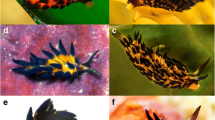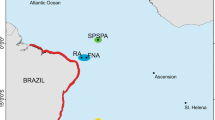Abstract
Species of the genus Hofstenia are voracious predators and among the largest and most colorful of the Acoela. They are known from Japan, the Red Sea, the North Atlantic islands of Bermuda and the Bahamas, and the Caribbean and in a variety of habitats including the rocky intertidal, among Thalassia sea grass, on filamentous algae and decaying mangrove leaves. Certain color morphs associated with each of these habitats seem to have confused the taxonomy of the group. While brown-and-white banding and spotting patterns of Hofstenia miamia and Hofstenia giselae are distinctive for species associated with mangrove leaves and Thallasia sp. and are likely to be cryptic for these specific environments, we find some evidence to suggest that the coloration is mimicry of a nudibranch with aposematic coloration. The common plan in these patterns is one with three variously solid or spotted lighter cross bands on a dark background. Our examination of museum type material and live specimens of Hofstenia collected from Bahamas, Belize, Bermuda, and Panama revealed no internal morphological differences between the Hofstenia species occurring in the Caribbean. Similarly, our analyses of 18S and 28S molecular sequence data revealed no significant differences among specimens. Accordingly, we declare that Hofstenia giselae is a junior synonym of Hofstenia miamia, the three-banded panther worm.







Similar content being viewed by others
References
Beltagi, S. M., 1958. Hofsteniidae und neue Acoela aus dem Roten Meer. Dissertation, Institut für Zoologie Wien, Nr. 333.
Bock, S., 1923. Eine neue marine Turbellariengattung aus Japan. Uppsala Universitets Årsskrift, Mathematik och Naturvetenskap 1: 1–52.
Bremer, K., 1994. Branch support and tree stability. Cladistics 10: 295–304.
Bresslau, E., 1933. Erster Klasse des Cladus Plathelminthes: Turbellaria. In Kukenthal, W. & Th. Krumbach (eds), Handbuch der Zoologie, Vol. 2, Part 1, 54–320.
Butler, J. K., 1979. Methods for improved light microscope microtomy. Stain Technology 54: 53–69.
Carranza, S., J. Baguña & M. Riutort, 1997. Are the Platyhelminthes a monophyletic primitive group? An assessment using 18S rDNA sequences. Molecular Biology and Evolution 14: 678–679.
Corrêa, D. D., 1960. Two new marine Turbellaria from Florida. Bulletin of Marine Science of the Gulf and Caribbean 10: 208–216.
Corrêa, D. D., 1963. The turbellarian Hofstenia miamia in the Caribbean Sea. Studies Fauna Curaçao 17: 38–40.
Dörjes, J. & T. G. Karling, 1975. Species of Turbellaria Acoela in the Swedish Museum of Natural History, with remarks on their anatomy, taxonomy and distribution. Zoologica Scripta 4: 175–189.
Doe, D. A., 1981. Comparative ultrastructure of the pharynx simplex in Turbellaria. Zoomorphology 97: 133–193.
Edgar, R. C., 2004. MUSCLE: Multiple sequence alignment with high accuracy and high throughput. Nucleic Acids Research 32: 1792–1797.
Ewing, B., L. Hillier, M. C. Wendl & P. Green, 1998. Base-calling of automated sequencer traces using phred. I. Accuracy assessment. Genome Research 8:175–185.
Ewing, B. & P. Green, 1998. Base-calling of automated sequencer traces using phred. II. Error probabilities. Genome Research 8:186–194.
Giberson, R. T. & R. S. Demaree Jr., 1995. Microwave fixation: Understanding the variables to achieve rapid reproducible results. Microscopy Research and Techniques 32: 246–254.
Goloboff, P., S. Farris & K. Nixon, 2000. TNT (Tree analysis using New Technology) (BETA) ver. 1.0 Published by the authors, Tucumán, Argentina.
Guindon, S. & O. Gascuel, 2003. A simple, fast, and accurate algorithm to estimate large phylogenies by maximum likelihood. Systematic Biology 52: 696–704.
Gundersen, R. W., 2003. Navanax aenigmaticus from Jamaica. [Message in] Sea Slug Forum. Australian Museum, Sydney. Available from http://www.seaslugforum.net/find.cfm?id=11126.
Hooge, M. D., P. Haye, S. Tyler, M. K. Litvaitis & I. Kornfield, 2002. Molecular systematics of the Acoela (Platyhelminthes) and its concordance with morphology. Molecular Phylogenetics and Evolution 24: 333–342.
Huelsenbeck, J. P. & F. Ronquist, 2001. MRBAYES: Bayesian inference of phylogeny. Bioinformatics 17: 754–755.
Karling, T. G., 1940. Zur Morphologie und Systematik der Alloeocoela Cumulata und Rhabdocoela Lecithophora (Turbellaria). Acta Zoologica Fennica 26: 1–260.
Lanave, C., G. Preparata, C. Saccone & G. Serio, 1984. A new method for calculating evolutionary substitution rates. Journal of Molecular Evolution 20:86–93.
Marcus, E. D. B., 1957. On Turbellaria. Anais da Academia Brasileira de Ciências 29: 153–191.
Meixner J., 1938. Turbellaria (Strudelwürmer). I. Allgemeiner Teil. In Grimpe, G., E. Wägler & A. Remane (eds), Die Tierwelt der Nord- und Ostee 33(IVb), 1–146.
Newman, L. J. & L. R. G. Cannon, 1994. Pseudoceros and Pseudobiceros (Platyhelminthes, Polycladida, Pseudocerotidae) from Eastern Australia and Papua New Guinea. Memoirs of the Queensland Museum 37: 205–266.
Newman, L. J. & L. R. G. Cannon, 2003. Marine Flatworms: The World of Polyclads. CSIRO Publishing, Collingwood, Victoria, 1–112.
Nylander, J. A. A., 2004. MrAIC.pl. Program distributed by the author. Evolutionary Biology Centre, Uppsala University.
Papi, F., 1957. Sopra un nuovo Turbellario arcooforo di particulare significato filetico e sulla posizione della fam. Hofsteniidae nel sistema dei Turbellari. Pubblicazioni Della Stazione Zoologica di Napoli 30: 132–148.
Riedl, R., 1954. Neue Turbellarien aus dem mediterranen Felslitoral. Zoologische Jahrbucher Abteilung für Systematik, Ökologie und Geographie der Tiere 82: 157–244.
Ronquist, F. & J. P. Huelsenbeck, 2003. MRBAYES 3: Bayesian phylogenetic inference under mixed models. Bioinformatics 19: 1572–1574.
Ruiz-Trillo, I., M. Riutort, D. T. J. Littlewood, E. A. Herniou & J. Baguña, 1999. Acoel flatworms: Earliest extant bilaterian metazoans, not members of the Platyhelminthes. Science 283: 1919–1923.
Smith, J. P. S. & S. Tyler, 1984. Serial sectioning and staining of resin-embedded material for light microscopy: Recommended procedures for micrometazoans. Mikroskopie 41: 259–270.
Staden, R., 1996. The Staden sequence analysis package. Molecular Biotechnology 5: 233–241.
Stefanini, M., C. De Martino & L. Zamboni, 1967. Fixation of ejaculated spermatozoa for electron microscopy. Nature 216: 173–174.
Steinböck, O., 1924. Die Bedeutung der Hofstenia atroviridis Bock für die Stellung der Alloeocoela im System der Turbellarien. Zoologischer Anzeiger (Jena) 59: 156–166.
Steinböck, O., 1966. Die Hofsteniiden (Turbellaria Acoela). Grundsätzliches zur Evolution der Turbellarien. Zeitschrift für Zoologische Systematik und Evolutionsforschung 4: 58–195.
Steinböck, O., 1967. Regenerationsversuche mit Hofstenia giselae Steinb. (Turbellaria Acoela). Roux’ Archiv für Entwicklungsmechanik der Organismen 158: 394–458.
Tavaré, S., 1986. Some probabilistic and statistical problems in the analysis of DNA sequences. Lectures on Mathematics in the Life Sciences 17: 57–86.
Tekle, Y. I., O. I. Raikova, A. Ahmadzadeh & U. Jondelius, 2005. Revision of the Childiidae (Acoela), a total evidence approach in reconstructing the phylogeny of acoels with reversed muscle layers. Journal of Zoological Systematics and Evolutionary Research 43: 72–90.
Tyler, S., S. Schilling, M. Hooge & L. F. Bush, 2006. Turbellarian taxonomic database. Version 1.5. Available via http://turbellaria.umaine.edu.
Acknowledgements
We are grateful to Klaus Rützler for the opportunity to work at Carrie Bow Cay and we thank Wolfgang Sterrer and Jörg Ott for their help in collecting specimens in Belize. We thank Rachel Collin of the Smithsonian Tropical Research Institute (STRI) for inviting us to be a part of the taxonomic survey at Bocas del Toro, Panama and for providing financial assistance and logistical support. We also extend our gratitude to Wolfgang Sterrer of the Bermuda Natural History Museum for his invaluable help in the collection of specimens in Bermuda and to the highly altruistic staff of the Perry Institute for Marine Science in Lee Stocking Island, Bahamas. Type material was generously made available to us by the Swedish Museum of Natural History and the Naturhistorisches Museum Wien. This is contribution no. 797 of the Caribbean Coral Reef Ecosystems Program, National Museum of Natural History, Smithsonian Institution, and contribution no. 125 of the Bermuda Biodiversity Project (BBP), Bermuda Aquarium, Natural History Museum and Zoo. This material is based upon work supported by the National Science Foundation under grant no. 0118804 (MH, ST) and the Swedish Research Council (UJ). Wallberg was kindly funded by Inez Johanssons stiftelse.
Author information
Authors and Affiliations
Corresponding author
Additional information
Handling editor: K. Martons
Electronic supplementary material
Below are the electronic supplementary materials.
Rights and permissions
About this article
Cite this article
Hooge, M., Wallberg, A., Todt, C. et al. A revision of the systematics of panther worms (Hofstenia spp., Acoela), with notes on color variation and genetic variation within the genus. Hydrobiologia 592, 439–454 (2007). https://doi.org/10.1007/s10750-007-0789-0
Received:
Revised:
Accepted:
Published:
Issue Date:
DOI: https://doi.org/10.1007/s10750-007-0789-0




